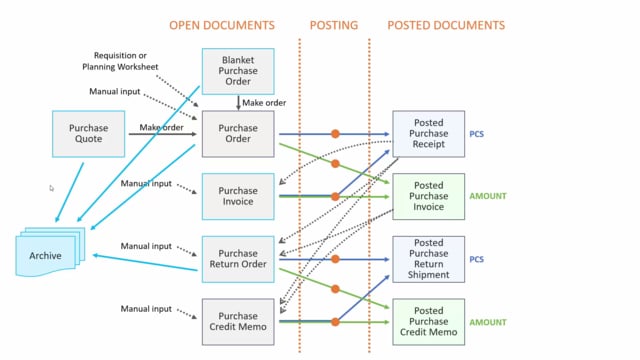
Playlists Manage
Log in to create a playlist or see your existing playlists.
Log inHow does open and posted purchase documents work in Business Central?
In Business Central, we have quite a few purchase documents, both open documents and posted documents.
This is what happens in the video
Actually they’re all based on the same few tables so if you look down into the data structure on the database level, it’s the same table with different types on.
So in real life, it’s quite simple how the open documents work with the type, how the posting routines is the same for all type of documents and how the posted documents are based on the same table structure.
But what you see is sorted in different types, so we have many different documents and I would show how those correlate.
First of all, on the open document side we have a purchase order.
A purchase order is where you can of course enter the quantity you want to buy from a vendor, quantities and prices.
And the purchase order also works together with the purchase quote and the purchase blanket order.
That means from a purchase quote that you could send to the vendor.
You can make a purchase order if you’re actually going to order it, from a purchase blanket order, which is a frame agreement you can make several orders, each time we want to buy some part of the frame agreement.
You could also enter the purchase order manually, just by entering it or it could be created from the MRP batch job in the requisition worksheet or the planning worksheet.
That’s the normal way to create purchase orders.
When posting a purchase order, you can post receipt and invoicing in two different steps, so normally you post the receipt in the warehouse, when the order hits the ramp or when the item hits the ramp, you receive the goods, enter quantity to receive and post it and that creates a posted purchase receipt, which is a matter of pieces and quantities.
Later on in the finance department, typically you will post the invoicing that creates a posted purchase invoice, which is another posted documents.
A purchase invoice is normally created manually, when you buy something and whereas the purchase order is typically an open list of documents that need to be received and some of them is received and not invoiced, the purchase orders list this normally empty, because you get the purchase order, sorry the purchase invoice, you enter the purchase invoice information and you post it.
A purchase invoice could be made manually or it could be created from a posted purchase receipt, meaning you could also receipt on several purchase orders, and then grab all the posted receipts into one purchase invoice and posted, which will of course also update the purchase order document.
Now the purchase invoice, when you post that, creates both transactions in one go, so you cannot separate the receipt and the invoicing.
Of course, if it’s based on a receipt document it’s already received when you invoice it, but if it’s not all made from a posted purchase receipt document, but just entered manually, you will post the purchase receipt and the purchased invoice documents in one go.
A purchased return order and a purchased credit memo has the same structure and same differences as a purchase order, and a purchase invoice.
That means the purchase returned order is a document where you can post the shipment, because we’re shipping it out of stock back to the vendor separately, and you can post the invoicing separately, whereas credit memo is made in one go.
And as you can see here, they can be fetched from a posted document, a posted received or a posted invoice, both the returned order and the credit memo.
So normally, when you want to return something you point on the document you have posted, that you want to reverse and that creates the open document, but it can also be entered manually.
And as you can see here the postings are separate from the return order, so often the return order is made as an agreement with the vendor and lies in the system, until the Warehouse people collects the item, pack them and then post the returned shipment, as a separate go.
Later on the finance department will post the purchase credit memo when they get it.
Whereas, the credit memo is posted in one go.
There’s an archiving functionality in the purchase setup table, where you can select which document you want to archive, so even though the open documents are all deleted when they are done, the archiving functionality makes it possible to save the documents history.
So normally, all open documents is deleted when you post the remaining quantities and invoices.
And of course on all those different documents you have a print, you can do, and this is an overview of print they will be explained in another video, more detailed and you can print all those documents, from your purchase documents.

